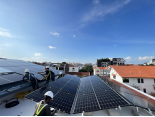Energiantuotannon maksimointi edellyttää säätöjen ymmärtämistä ja niiden vaikutusta aurinkopaneelien tehokkuuteen. Ympäristötekijät voivat joko edistää tai haitata aurinkopaneelin energiantuotantoa.
1. Lämpötilan vaikutus aurinkopaneeleihin
Lämpötila on yksi vaikutusvahvimmista tekijöistä aurinkopaneelien suorituskyvyn kannalta. Tasapaino on välttämätöntä, sillä aurinkopaneelit tarvitsevat toimiakseen valoa, ja korkeat lämpötilat voivat haitata toimintaa. Useimmille aurinkopaneeleille parhaat suorituskyvyt saavutetaan noin 25 °C (77 °F):ssa. Tätä korkeammissa lämpötiloissa suorituskyky heikkenee, sillä sähköinen hyötysuhde laskee 0,5 %:lla jokaista Celsius-astetta kohti. Tämä voi olla ongelma alueille, joilla on korkeita ympäristön lämpötiloja.
2. Pilvien vaikutus aurinkoenergiantuotantoon
Pilvisä sääolosuhteet voivat merkittävästi vaikuttaa aurinkopaneelien tehokkuuteen. Kun pilvet peittävät auringon, paneelien saama auringonvalo heikkenee, mikä laskee energiatuotantoa. On tärkeää muistaa, että aurinkopaneelit pystyvät silti tuottamaan sähköä pilvisinä päivinä, vaikka selvästi pienemmällä teholla. Tehon lasku vaihtelee pilvien paksuuden sekä käytössä olevan aurinkoteknologian mukaan. Esimerkiksi kahden puolen valoa keräävät aurinkopaneelit ovat parempia keräämään hajavaloa verrattuna muihin perinteisiin aurinkopaneeleihin. Näin ollen ne soveltuvat paremmin pilvisiin tai sateisiin olosuhteisiin.
3. Sade ja sen hyödyt aurinkopaneeleille
Auringonpaneeliin, johon osuu kevyt sade, voi vaikuttaa lievä vähennys auringonvalon määrässä. Toisaalta tällainen sää voi olla hyödyksi, koska sade puhdistaa paneelien pintoja likasta ja näin parantaa niiden toimintaa. Tätä puhdistusvaikutusta vahvistaa auringon lämpötila ja viileämpi lämpötila. Auringonpaneelit, jotka toimivat tehokkaammin lämpimässä ilmassa, voivat saavuttaa uuden tehokkuustason, kun aurinko palaa esiin, erityisesti sadekuuron jälkeen, mikä parantaa niiden toimintaa.
4. Lumen vaikutus auringonpaneeliin
Auringonpaneelit peittyvät lumelle joillakin alueilla. Lumen peite voi haitata energiantuotantoa. Hyvä uutinen on, että auringonpaneelit käyttävät auringon lämpöä, joka voi auttaa lumien sulamisessa. Lisäksi lumi voi edistää energiantuotantoa heijastamalla valoa. Näin ollen lumesta aiheutuvat haitat eivät usein kestä kauan, koska paneelit lämmittävät pian.
5. Tuulen vaikutus auringonpaneeliin
Aurinkoenergiaa voi vaikuttaa myös tuuli. Lämpimämmillä alueilla tuuli voi vahvistaa aurinkopaneeleita jäähdyttämällä niitä, mutta aurinkovoimalaitokset voivat kärsiä voimakkaasti myrskylentelyistä ja hurrikaaneista. Oikein asennettujen ja kiinnitettyjen paneelien ansiosta voidaan kestää kovia tuulia ja poikkeuksellista säätä samalla kun paneelit pysyvät toimivina.
Johtopäätöksenä aurinkopaneeleihin voi vaikuttaa säät; kuitenkin teknologian edetessä aurinkopaneeleista tulee yhä kestävämpiä lumelle, tuulelle ja muille sääolosuhteille. Aurinkoteknologia säilyy toimivana. Näiden tekijöiden ymmärtäminen auttaa kuluttajia tekemään perusteltuja päätöksiä aurinkopaneeleiden hankinnassa.
Trendit ja muutokset teollisuudessa
Kuten muualla maailmassa, aurinkovoimalakin muuttuu jatkuvasti. Aurinkoenergiapaneelien tehokkuuden ja luotettavuuden parantamiseksi pyritään jatkuvasti. Innovaatioita, kuten älykkäitä aurinkopaneelia, joita käytetään tekoälyä, kehitetään parantaakseen energiaa sääolosuhteiden mukaan. Sen lisäksi viime vuosina ilmastokysymysten tietoisuus on kannustanut ihmisiä käyttämään uusia, puhtaampia energialähteitä, kuten aurinkoenergiaa. Tämä puolestaan johtaa aurinkopaneeleissa käytettyjen tekniikoiden ja käytäntöjen parantumiseen.




